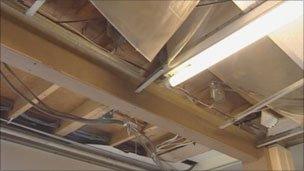School building cash gap expected for councils
- Published

Councils meet 30% of the cost, while the assembly government pays the rest
Figures suggest the assembly government's biggest ever school building project may not be affordable.
A funding shortfall of hundreds of millions of pounds is expected as councils submit plans to bring school buildings up to scratch.
BBC Wales found more than half of councils had a "wish list" totalling £2.86bn, but council leaders warn of "significant disappointment".
The assembly government said all plans would be "evaluated".
Its entire budget for education building projects over the next three years is £478m but it has not said how much money will be available for the 21st Century Schools programme.
Friday is the deadline for councils to put forward their proposals for the school building scheme.
This can involve everything from brand new school sites to upgrading existing facilities.
All 22 Welsh councils have surveyed schools. Councils must find 30% of the money for new schools, while the assembly government must provide 70%.
From those that have so far responded to BBC Wales' survey, initial requests for funding - from 2012 to 2015 - total £815.4m.
The programme is a partnership between the assembly government and the Welsh Local Government Association (WLGA).
Chris Llewelyn, director of lifelong learning at the WLGA, said it was "safe to say" there would be disappointment for schools.
"We know that capital is being cut by 14% for the forthcoming year and we expect to see further cuts so it's reasonable to assume there will be significant disappointment," he said.
A report this summer found school buildings were in a poor state following "weaknesses" in the management of the investment programme.
Monmouthshire council would like a new school for Caldicot comprehensive, which was built in the 1950s.
That would cost £39m alone, which is around a quarter of the assembly government's entire budget for education building projects in any of the next three years.
Head teacher Susan Gwyer-Roberts said: "Looking after the fabric of the buildings takes away funds which would go into teaching and learning."
Liz Hackett Payne, Monmouthshire council's cabinet member for children, young people and learning, said: "First of all, our main aim of everything was to raise standards.
"After that, we wanted to listen to what the young people had to say to us - what did they want from their schools. This came into our 21st Century Schools Programme."
An auditor general's report this summer, based on an audit in 2008-09, looked at whether investment in school buildings had been managed "to best effect".
It found there was a long way to go before all school buildings were "fit for purpose", but said many pupils and teachers had benefited from a "much improved working environment".
The assembly government said the 21st Century Schools programme was more than just a funding scheme and was about "creating the right learning environments for children alongside improvements to teaching and learning".
'Feedback provided'
"The programme will bring together resources and expertise to create the right schools in the right places across Wales - a sustainable system for the future, meeting a 21st Century school standard," said a spokesperson.
Councils have been asked to submit strategic plans by Friday, which will then be "evaluated and feedback provided".
"Following this, discussions with authorities will take place to develop a strategic long-term programme of investment against the background of the priority and readiness of the projects and in the context of the funding available.
"We anticipate that announcements will take place in summer 2011."
- Published3 December 2010
- Published14 July 2010